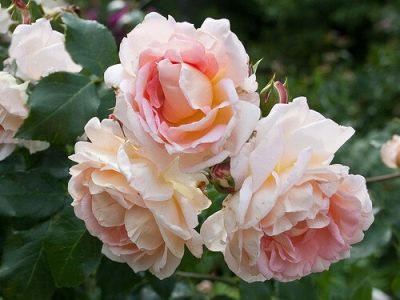
- Authors: W. Kordes' Söhne
- Name synonyms: Amaretto (KORaugneru)
- Breeding year: 2018
- Group: floribunda
- The main color of the flower: pink
- Flower shape: cupped
- Flower size: medium
- Diameter, cm: 6-7
- Flower type by number of petals: thick double
- Scent: fruity
Pink shrubs are very popular among connoisseurs of flowering flower beds, gardens, beautifully decorated hedges. One of the unpretentious and long-blooming roses is the Amaretto variety, which can grow in different climatic zones.
Breeding history
The Amaretto climbing rose is a representative of German selection, bred relatively recently, but quickly won the sympathy of many gardeners and summer residents. The culture was bred in 2006, but over the years there has been an improvement and cultivation of the flower. In 2018, an updated Amaretto variety was introduced with the characteristics that make the rose shrub perfectly adapt to different climatic conditions. Authorship belongs to W. Kordes Sohne.
Description of the variety
Rosa Amaretto is a compact shrub that, in a favorable environment, stretches to a height of 70-90 cm.The diameter of the bush varies between 50-60 cm.The shrub is characterized by abundant thickening of large, dark green leaves with a pronounced gloss, strong and flexible stems, powerful root system and sparsely spiked stems with long spines. The plant has a good growth rate.
Advantages and disadvantages
Amaretto is valued not only for its attractive appearance, but also for a number of advantages that the rose bush is endowed with - good frost resistance, abundant and prolonged flowering, strong immunity, due to which the plant rarely gets sick, excellent tolerance to rains and prolonged heat.
Flowering features
This pink species belongs to the class of profusely flowering varieties. The rose blooms for a long period - from June to the end of September. The goblet buds of a pale pink color are neatly collected in inflorescences. Dense double roses of incredible beauty have a bowl-like shape, including 40-60 petals. The diameter of the flower is 6-7 cm. At the moment of blooming, the flower has a creamy apricot color, and when fully opened, it becomes pale pink. A distinctive feature of the variety is the presence of a pink-red border.
At the peak of its flowering, the shoots of the shrub elegantly bend under the weight and abundance of flowers. The aroma of the rose is very pleasant, with pronounced fruity notes.
Use in landscape design
The German Amaretto rose is a showy plant that is widely used in landscaping. The rose bush is ideal for creating a hedge, arch, column decoration, garden zoning.
In addition, the Amaretto rose goes well with perennial flowering vines, as well as purple and blue-blue flowers. Cut roses look great in a vase of water, where they can stand for about 2 weeks, filling the kitchen or living room with aroma.
Landing
Shrubs are planted from March to May, when the temperature is stable, and autumn plantings are also allowed - September-October (preferably southern regions). For cultivation, a place is chosen in the southern part of the garden or plot, where there is a lot of heat and sun, and there is also a barrier from drafts and gusty winds. When planting seedlings, it is recommended to observe the planting density - 4-5 units per 1 m2.
For a plant, fluffy, light, enriched with organic components of the soil, which breathe, allow moisture to pass through, are comfortable. It should be borne in mind that the soil should not be acidic and waterlogged. It is not recommended to land in lowlands where melted snow accumulates. The groundwater flow should also be deep - at the level of 1.5-2 meters.
Growing and caring
The plant is grown using seedlings. Before planting, the rhizomes of seedlings should be treated with a growth stimulator. Drainage and fertilizers are added to each prepared hole. Plants are planted at a slight angle, well watered with settled water, and lightly sprinkled with a light layer of peat mulch.
Agrotechnics of a flower shrub consists of basic procedures - watering with warm water at the root, fertilizing, loosening the soil, removing weeds, sanitizing pruning and preventing viruses. In addition, do not forget to remove all dried flowers on the bushes. In winter, shrubs are insulated using mulching or special covering materials.
Watering and feeding
The rose bush needs regular watering with settled water (12-15 liters per bush). During the dry summer, watering can be increased to 15-20 liters per bush. Water is introduced slowly, at the root. In order for the bush to grow rapidly and bloom, it is necessary to timely apply fertilizers - nitrogen (in spring) and potassium-phosphorus mixtures (in autumn).
Pruning
The shrub needs 2-3 pruning. In early spring, frozen shoots are removed, and the tops are also shortened. In the summer, the appearance of wilted roses on the bushes is controlled. In autumn, sanitary pruning is performed, when they get rid of damaged shoots, sometimes thinning of the bushes is carried out. Experienced growers recommend anti-aging pruning if the condition of the shrub requires it.
Frost resistance and preparation for winter
Rose Amaretto is quite frost-resistant, can withstand temperatures down to -18 ... 23 degrees. At the same time, in regions with severe and little snowy winters, shrubs need good shelter. After the autumn pruning, the shoots are gently bent to the ground and sprinkled with a thick layer of sawdust or spruce mulch. Some gardeners prefer to cover the rose bushes with agrofibre or film. In early spring, the shelter is removed in order to prevent the plant from growing and dying.
Diseases and pests
Due to its good immune defense, the Amaretto rose bush is extremely rarely exposed to fungal and other diseases. It is worth noting the resistance of shrubs to powdery mildew and black spot. Among the pests that occasionally attack pink plantings, you can find aphids, leaf rollers and spider mites.































































